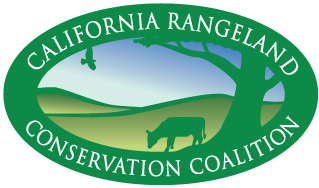It Started at a BBQ!
What do California Cattlemen’s Association, Defenders of Wildlife, California Farm Bureau Federation, Natural Resources Conservation Service, and Sierra Foothills Audubon all have in common? Privately owned ranches and rancher stewardship!
Steve Thompson, then US Fish and Wildlife Service (FWS) Southwest Region Director and Assistant Region Director, Paul Henson were criticized by diverse conservation organizations for not doing enough to protect the most threatened habitat in California. He challenged them to provide him a general description of the land area they had the most concern about. When they did, he pointed out that their area of concern is primarily privately owned ranches. To promote their conservation goals they would have to communicate with the ranchers.
Several important events had recently occurred that involved ranching with the Endangered Species Act (ESA). Tim Koopmann, an Alameda County developer, California Rangeland Trust (which is led by ranchers) and California Department of Fish and Game had recently negotiated a mitigation easement at Koopmann Ranch for California Tiger Salamander (CTS) that recognized the normal ranching activities required to sustain the habitat and salamander. FWS was proposing to list the CTS as endangered and was negotiating with the California Cattlemen’s Association (Noelle Cremers, staff lead) to develop the first 4d exemption* to the ESA. FWS acknowledged the importance of grazing and ranching to conserving their habitat, and the 4d exempts a list of agreed ‘routine ranching activities’ from the take provision of ESA. When FWS listed the CTS Steve Thompson, aware of the Koopmann easement asked Tim to host a gathering of diverse organizations and media to announce the listing and to demonstrate how essential ranching is to the CTS and its habitat.
As a result of this collaboration Steve asked Tim to subsequently host a gathering of ranching and conservation organizations and agencies to expand the conversation about ranching and wildlife habitat. The organizations listed below came together in August, 2005 for a BBQ. They explored what they had in common and how they might communicate and work together to keep ranchers ranching and the conservation values intact and perhaps enhanced in the region. The Koopmann Ranch story* about the CTS easement, estate tax burden, pond restoration permitting hurdles, and development threats set the stage for meaningful discussion. Several conservation groups explained how they had come to realize the role of ranching and grazing for habitat. Ed Pandolfino noted that Sierra Foothills Audubon’s own studies showed that grazing was essential to grassland bird habitat, contrary to its presumptions. All agreed the major threats to ranching at that time were regulatory burdens and loss of ranches to development. They agreed on a geographical focus area and a general strategy that acknowledges that ranching viability and stewardship are critical to sustain ranching and those rangelands. Within a few months the Rangeland Resolution was approved and the first Summit was being planned.
Founding entities: Alameda County Resource Conservation District, Butte Environmental Council, California Cattlemen’s Association; California Association of Resource Conservation Districts, California Farm Bureau Federation, California Oaks Federation, California Rangeland Trust, Defenders of Wildlife, Environmental Defense Fund, Institute for Ecological Health, National Fish and Wildlife Foundation, Natural Resources Conservation Service, Sierra Foothills Audubon, The Nature Conservancy, US Fish and Wildlife Service, and Wildlife Conservation Board. These individuals and entities continue to participate in the Coalition with leadership and resources, for which the Coalition is grateful. Read about our Roots.
* The 4d rule exempts routine ranching practices from the prohibitions of the ESA, including taking, harming and harassing listed species. The U.S. Fish and Wildlife Service has recognized that ranching activities including grazing and maintenance of stock ponds benefit the California Red-Legged Frog and the California Tiger Salamander.
* Since 2005 Koopmann Ranch has acquired additional mitigation easements held by the California Rangeland Trust that are very compatible with ranching.
